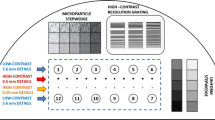Abstract
The promise of digital mammography has focused considerable resources on the challenges of mammography workstations, but the risk of wasted time and resources in such efforts is very high. Although final testing of the workstation’s image quality and ergonomics is common, a number of interim evaluation and refinement techniques can be applied throughout the design and development process. The use of such techniques holds potential not only to save time and money but also to produce a superior workstation.
Similar content being viewed by others
References
Behlen F, Blume H, Flynn MJ, et al: Report of the Working Group on Digital Mammography: Digital Displays and Workstation Design, Sponsored by USPHS Office on Women’s Health and NCI, March 9–10, Washington, DC
Mantei MM, Teorey TJ: Cost/benefit analysis for incorporating human factors in the software life cycle. CACM, April, 1988
Horii CS: Electronic Imaging Workstations: Ergonomic issues and the User Interface, Radiographics 12:773–787, 1992
Horii CS, Horii HN, Mun SK, et al: Environmental designs for reading from imaging workstations: Ergonomic and architectural features. J Digit Imaging 2:156–162, 1989
Johnson CW: Impact of working environments upon human-machine dialogues: A formal logic for the integrated specification of physical and cognitive ergonomic constraints on user interface design. Ergonomics 39:512–530, 1996
Gale AS, Worthington BS: The Utility of Scanning Strategies in Radiology, Eye Movements and Psychological Functions: International Views. Hillsdale, NJ, Erlbaum, 1983
Beard DV, Bream P, Pisano ED, et al: A pilot study of eye movement during mammography interpretation: Eyetracker results and workstation design implications. J Digit Imaging Feb, 1996
Huang HK, Wong AWK, Zhu X: Performance of asynchronous transfer mode (ATM) local are and wide area networks for medical image transmission in clinical environment. J Comput Med Imaging Graphics 21:165–173, 1997
Roehrig H, Blume H, Browne M: Performance test and quality control of cathode ray tube displays. J Digit Imaging 3:134–150, 1990
Krupinski E, Roehrig H: Influence of monitor luminance and tone scale on Observer Detection Performance. Medical Imaging 98: Image Perception 3340: 1998
Metz CE: Basic Principles of ROC analysis. Semin Nucl Med 8:283–298, 1978
Metz CE: Evaluation of digital mammography by ROC analysis, in Doi K, Giger ML, Nishikawa RM, (eds): 3rd International Workshop on Digital Mammography, Amsterdam, Elsevier Science (Excerpta Medica International Congress series), 1996, pp 61–68
Metz CE: Evaluation of radiologic imaging systems by ROC analysis. Med Imag Inform Sci 12:113–121, 1995
McKay EN: Developing User Interfaces for Microsoft Windows. Redmond, WA, Microsoft Press, 1999
Apple Computer Inc: Macintosh Human Interface Guidelines. Reading, MA, Addison-Wesley, 1992
Hackos JT, Redish JC: User and Task Analysis for Interface Design, New York, NY, Wiley, 1998
Dix AJ, Finlay JE, Abowd GD, et al: Human-Computer Interaction (ed 2) London, England, Prentice Hall, 1998
Card SK, Moran TP, Newell A: The Psychology of Human-Computer Interaction. Hillsdale, NJ, Lawrence Erlbaum Associates, 1983
Beard DV, Smith DK, Denelsbeck KM: Quick and Dirty GOMS: A Case Study of Computed Tomography Interpretation. J Human Computer Interaction 11:157–180, 1996
Beard DV, Molina PL, Muller KE, et al: Interpretation Time of serial chest CT examinations with stacked-metaphor workstation versus film alternator. J Radiol 197:753–758, 1995
Beard DV, Hemminger BM, Denelsbeck KM, et al: Cognitive load during CT interpretation, SPIE Medical Imaging: Image Perception, 1994
Kilpatrick KE, Mackenzie RS, Kisko TM: Expanded function auxiliaries in general dentistry: A computer simulation. Health Services Research. vol 7:288–300, 1972
Author information
Authors and Affiliations
Rights and permissions
About this article
Cite this article
Beard, D.V. Iterative interim techniques for reduced costs and a better mammography workstation: An opinion. J Digit Imaging 13, 170–174 (2000). https://doi.org/10.1007/BF03168391
Issue Date:
DOI: https://doi.org/10.1007/BF03168391




